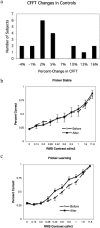Perceptual learning of motion leads to faster flicker perception
- PMID: 17183655
- PMCID: PMC1762365
- DOI: 10.1371/journal.pone.0000028
Perceptual learning of motion leads to faster flicker perception
Abstract
Critical flicker fusion thresholds (CFFT) describe when quick amplitude modulations of a light source become undetectable as the frequency of the modulation increases. The threshold at which CFF occurs has been shown to remain constant under repeated testing. Additionally, CFF thresholds are correlated with various measures of intelligence, and have been regarded by clinicians as a general measure of cortical processing capacity. For these reasons, CFF is used as a cognitive indicator in drug studies, as a measure of fatigue, and has been suggested as a diagnostic measure for various brain diseases. Here we report that CFFT increases dramatically in subjects who are trained with a motion-direction learning procedure. Control tasks demonstrate that CFFT changes are tightly coupled with improvements in discriminating the direction of motion stimuli, and are likely related to plasticity in low-level visual areas that are specialized to process motion signals. This plasticity is long-lasting and is retained for at least one year after training. Combined, these results show that CFFT relates to a specialized sensory process and bring into question that CFFT is a measure of high-level, or general, processes.
Conflict of interest statement
Figures





Similar articles
-
Visual experience can substantially alter critical flicker fusion thresholds.Hum Psychopharmacol. 2005 Jan;20(1):55-60. doi: 10.1002/hup.661. Hum Psychopharmacol. 2005. PMID: 15568203
-
Spatiotemporal flicker detector model of motion silencing.Perception. 2014;43(12):1286-302. doi: 10.1068/p7772. Perception. 2014. PMID: 25669047
-
Two Visual Training Paradigms Associated with Enhanced Critical Flicker Fusion Threshold.Front Psychol. 2016 Oct 26;7:1597. doi: 10.3389/fpsyg.2016.01597. eCollection 2016. Front Psychol. 2016. PMID: 27833569 Free PMC article.
-
[Critical flicker fusion frequency in psychopathology and psychopharmacology. Review of the literature].Acta Psychiatr Belg. 1982 Jan-Feb;82(1):7-112. Acta Psychiatr Belg. 1982. PMID: 6751024 Review. French.
-
[Effects of antidepressants on cognitive functions. Review of the literature].Encephale. 1994 Jan-Feb;20(1):65-77. Encephale. 1994. PMID: 8174512 Review. French.
Cited by
-
Interactions between the spatial and temporal stimulus factors that influence multisensory integration in human performance.Exp Brain Res. 2012 May;219(1):121-37. doi: 10.1007/s00221-012-3072-1. Epub 2012 Mar 24. Exp Brain Res. 2012. PMID: 22447249 Free PMC article.
-
Spatial shifts of audio-visual interactions by perceptual learning are specific to the trained orientation and eye.Seeing Perceiving. 2011;24(6):579-94. doi: 10.1163/187847611X603738. Seeing Perceiving. 2011. PMID: 22353537 Free PMC article.
-
Individual differences in the multisensory temporal binding window predict susceptibility to audiovisual illusions.J Exp Psychol Hum Percept Perform. 2012 Dec;38(6):1517-29. doi: 10.1037/a0027339. Epub 2012 Mar 5. J Exp Psychol Hum Percept Perform. 2012. PMID: 22390292 Free PMC article.
-
Is task-irrelevant learning really task-irrelevant?PLoS One. 2008;3(11):e3792. doi: 10.1371/journal.pone.0003792. Epub 2008 Nov 24. PLoS One. 2008. PMID: 19030107 Free PMC article.
-
Evaluation of Critical Flicker-Fusion Frequency Measurement Methods for the Investigation of Visual Temporal Resolution.Sci Rep. 2017 Nov 15;7(1):15621. doi: 10.1038/s41598-017-15034-z. Sci Rep. 2017. PMID: 29142231 Free PMC article.
References
-
- Plateau J. On certain properties of the impressions produced by light upon the organ of sight. Liege: University of Liege; 1829.
-
- Lee BB, Pokorny J, Smith VC, Martin PR, Valberg A. Luminance and chromatic modulation sensitivity of macaque ganglion cells and human observers. J Opt Soc Am A. 1990;7:2223–2236. - PubMed
-
- Zlody RL. The relationship between critical flicker frequency (CFF) and several intellectual measures. Am J Psychol. 1965;78:596–602. - PubMed
-
- Tanner WP. A Preliminary Investigation of the Relationship between Visual Function of Intermittent Light and Intelligence. Science. 1950;112:201–203. - PubMed

